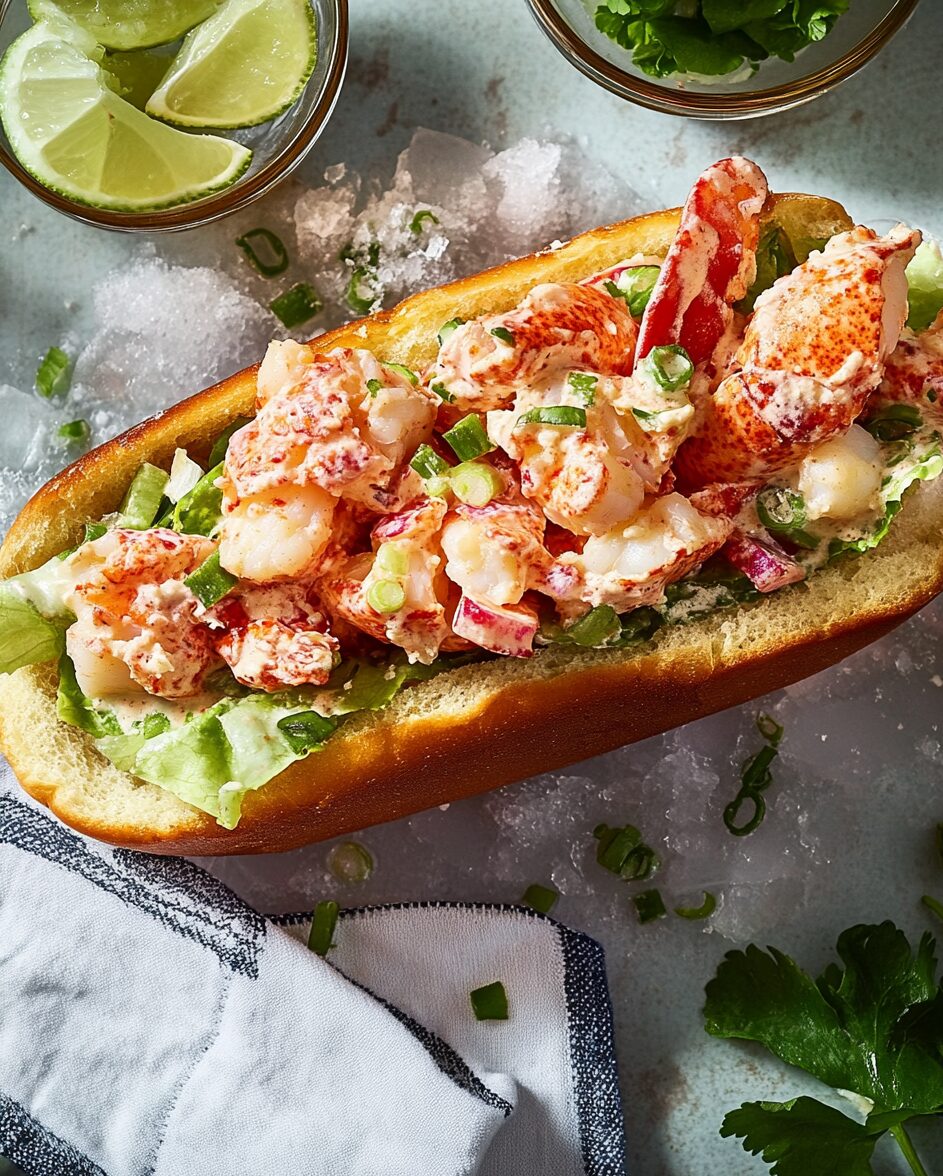Lobster Rolls are a quintessential New England dish, beloved for their rich yet refreshing flavors. The tender, sweet lobster meat is lightly coated in a tangy lemon-mayo dressing and balanced with the crunch of celery. Served in a warm, buttered roll, this dish offers the perfect blend of indulgence and simplicity.
Perfect for summer gatherings, beachside picnics, or a quick gourmet lunch, Lobster Rolls bring the fresh flavors of the sea to your plate. The toasted, buttery bun provides the perfect contrast to the cool, creamy filling, making each bite a celebration of texture and taste. A true seafood lover’s dream!
Full Recipe
Ingredients:
- 4 split-top hot dog buns
- 1 lb cooked lobster meat, chopped
- 2 tbsp mayonnaise
- 1 tbsp fresh lemon juice
- 1 stalk celery, finely chopped
- Salt and pepper, to taste
- 2 tbsp melted butter
- Fresh chives for garnish (optional)
Directions:
- In a medium bowl, combine the lobster meat, mayonnaise, lemon juice, celery, salt, and pepper. Stir until evenly coated.
- Heat a skillet over medium heat and brush the inside and outside of each hot dog bun with melted butter.
- Toast the buns in the skillet for 2-3 minutes on each side, until golden brown and crispy.
- Fill each bun with the lobster mixture, garnish with fresh chives if desired, and serve immediately.
Prep Time: 10 minutes | Cooking Time: 5 minutes | Total Time: 15 minutes
Kcal: 320 kcal | Servings: 4 servings
Popular Sides:
- French fries
- Coleslaw
- Pickles
- Chips
Fun Facts:
- Lobster rolls were initially a way to make lobster accessible to more people as a simple sandwich.
- It’s a popular summer dish, often found in coastal towns in the northeastern United States.
History of Lobster Rolls:
- Origins: The first recorded lobster roll was served at a restaurant in Milford, Connecticut, in the 1920s. Since then, it became a staple of the New England seafood scene, with Maine lobster becoming the most famous.
- From Humble Beginnings: Lobster was once considered a poor man’s food, served to prisoners or used as fertilizer. Over time, as lobsters became harder to catch and more popular, they turned into a delicacy, and the lobster roll became a symbol of indulgence and coastal living.
Classic Lobster Roll Variations:
- Cold vs. Warm: Lobster rolls come in two main forms:
- Maine-style (cold): Lobster meat is chilled and mixed with mayonnaise, often with lemon juice, celery, and seasonings. It’s served in a toasted buttered roll.
- Connecticut-style (warm): Lobster meat is warmed in melted butter and served without mayo in a toasted bun, highlighting the buttery flavor.
- Buns: The roll used is usually a split-top bun. It’s buttered and lightly toasted to achieve a crispy outer layer while staying soft inside. The split-top shape helps to keep the lobster meat in place.
Best Lobster Roll Toppings and Add-ons:
- Simple Seasoning: Most lobster rolls stick to simple seasonings—salt, pepper, and lemon juice—to allow the lobster’s natural flavor to stand out.
- Add-ins: Some variations include finely chopped celery, a dash of paprika, or even tarragon for a fresh, herbaceous note.
- Toppings: Lobster rolls can be finished with a sprinkle of chives or fresh herbs, adding color and flavor without overpowering the lobster.
Tips for Making the Perfect Lobster Roll:
- Use Fresh Lobster: Fresh, tender lobster meat is key. If possible, use lobster that has been freshly cooked and cooled or freshly buttered for warm versions.
- Toasting the Bun: A well-toasted, buttered bun adds an essential layer of texture—crisp on the outside, soft on the inside.
- Minimal Additions: Keep the recipe simple. Lobster is the star, so avoid overpowering it with too many extras. Stick to light seasonings and simple dressings.
Lobster Roll Serving Suggestions:
- Pair it with crispy fries, potato chips, or coleslaw for a traditional touch. Some also serve it with a side of pickles or sweet corn.
- A chilled drink, such as lemonade, iced tea, or a cold beer, complements the richness of the lobster.
Cultural Significance of Lobster Rolls:
- New England Icon: Lobster rolls are synonymous with coastal New England life, representing a laid-back, seafood-driven culture. They’re a symbol of summer, seafood festivals, and ocean-front dining. Many seafood lovers take annual road trips to Maine or Cape Cod to find the best lobster rolls.
- Lobster Shacks and Seafood Trucks: Small lobster shacks are popular destinations for tourists and locals alike. These simple roadside stands serve fresh lobster rolls to people enjoying a beach day or a summer vacation, often located along scenic highways or near fishing piers.
- A Global Influence: While lobster rolls started as a regional dish, they’ve gained popularity worldwide. In places like London, Tokyo, and Sydney, gourmet versions of the dish are served in upscale restaurants. Global chefs have also introduced fusion twists, combining local flavors with traditional New England lobster rolls.
Types of Lobsters Used:
- Maine Lobster: The most common type used in lobster rolls is the American lobster (Homarus americanus), specifically from the cold waters of the North Atlantic near Maine and Canada. This lobster is known for its tender, sweet meat.
- Spiny Lobster: In warmer regions like Florida and the Caribbean, spiny lobsters are sometimes used. Unlike Maine lobsters, spiny lobsters have no claws, and their meat comes mainly from the tail. Their flavor is slightly milder, and their texture is a bit firmer.
Preparing Lobster for the Perfect Roll:
- Boiling Whole Lobster: For many traditionalists, the process begins with boiling whole lobsters. Add salt and sometimes seaweed to the water for extra flavor, and cook until the lobster shells turn bright red (around 8-12 minutes, depending on the lobster size).
- Lobster Tail Meat: If you want a quicker method, you can use just lobster tails, which are often easier to handle than boiling whole lobsters. Boil or steam the tails for about 5-7 minutes, then remove the meat.
- Chilling the Lobster: For Maine-style lobster rolls, the lobster meat is chilled after cooking. This ensures a refreshing, cool bite that contrasts nicely with the buttery toasted roll.
- Warming the Lobster: For Connecticut-style lobster rolls, the lobster meat is gently warmed in melted butter, ensuring every bite is rich and luxurious. This style is preferred by those who love buttery lobster without mayo.
Lobster Roll Pairing Ideas:
- Chips or Fries: Classic sides for lobster rolls include potato chips or French fries. Their crunch complements the softness of the roll and lobster.
- Clam Chowder: A popular pairing is a cup of New England clam chowder, especially on cooler summer days. The creamy chowder, full of clams and potatoes, adds another layer of rich seafood flavors to the meal.
- Coleslaw: Light and tangy coleslaw offers a refreshing contrast to the richness of the lobster. It’s often served as a side or even placed directly in the lobster roll for extra crunch.
- Pickles: Pickles (usually dill or bread-and-butter) are frequently served on the side to cut through the buttery richness with a tangy bite.
- Beer and Lobster Rolls: Pair your lobster roll with a light beer—a lager, pilsner, or wheat beer work well. The beer’s crispness helps balance the richness of the lobster meat and butter.
- Sparkling Wine: For a more upscale pairing, a glass of sparkling wine or champagne brings out the lobster’s sweetness. The bubbles help cleanse the palate between bites, making the meal feel lighter.
Storing and Reheating Lobster:
- Leftover Lobster: If you have leftover lobster meat, store it in an airtight container in the refrigerator for up to two days. It’s best to consume lobster as fresh as possible, as the texture and flavor diminish with time.
- Reheating: To gently reheat lobster meat for a warm lobster roll, simmer it in melted butter on low heat for 2-3 minutes, ensuring the meat stays tender and doesn’t become rubbery.
Conclusion
Lobster rolls are a cherished culinary staple that originated in New England but have gained global recognition for their simplicity, flavor, and versatility. Whether served cold with mayonnaise in the Maine-style or warm and buttered in the Connecticut-style, these rolls highlight the delicate, sweet taste of fresh lobster meat. From traditional seafood shacks to upscale restaurants, lobster rolls continue to evolve, with chefs adding creative twists and health-conscious alternatives. Paired with crisp fries, refreshing coleslaw, or a light beer, lobster rolls offer a perfect balance of rich, buttery flavors and textures, making them a summertime favorite across coastal regions and beyond.

